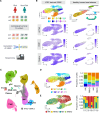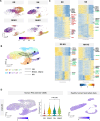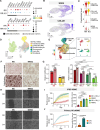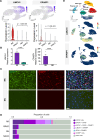The 9p21.3 Coronary Artery Disease Risk Locus Drives Vascular Smooth Muscle Cells to an Osteochondrogenic State
- PMID: 40143812
- PMCID: PMC12017600
- DOI: 10.1161/ATVBAHA.124.322045
The 9p21.3 Coronary Artery Disease Risk Locus Drives Vascular Smooth Muscle Cells to an Osteochondrogenic State
Abstract
Background: Genome-wide association studies have identified common genetic variants at ≈300 human genomic loci linked to coronary artery disease susceptibility. Among these genomic regions, the most impactful is the 9p21.3 coronary artery disease risk locus, which spans a 60-kb gene desert and encompasses ≈80 SNPs (single nucleotide polymorphism) in high linkage disequilibrium. Despite ≈2 decades since its discovery, the role of the 9p21.3 locus in cells of the vasculature remains incompletely resolved.
Methods: We differentiated induced pluripotent stem cells (iPSCs) from risk, nonrisk donors at 9p21.3, and isogenic knockouts into vascular smooth muscle cells (VSMCs). We performed single-cell transcriptomic profiling, including coembedding and comparison with publicly available human arterial data sets. We conducted functional characterization using migration and calcification assays and confirmed our findings on iPSC-VSMCs derived from additional donors. Finally, we used overexpression of ANRIL followed by gene expression analysis.
Results: We demonstrated that iPSC-VSMCs harboring the 9p21.3 risk haplotype preferentially adopt an osteochondrogenic state and show remarkable similarity to fibrochondrocytes from human artery tissue. The transcriptional profile and functional assessment of migration and calcification capacity across iPSC-VSMC lines from multiple donors concordantly resemble an osteochondrogenic state. Importantly, we identified numerous transcription factors driving different VSMC state trajectories. Additionally, we prioritized LIMCH1 and CRABP1 as signature genes critical for defining the risk transcriptional program. Finally, overexpression of a short isoform of ANRIL in 9p21.3 knockout cells was sufficient to induce the osteochondrogenic transcriptional signature.
Conclusions: Our study provides new insights into the mechanism of the 9p21.3 risk locus and defines its previously undescribed role in driving a disease-prone transcriptional and functional state in VSMCs concordant with an osteochondrogenic-like state. Our data suggest that the 9p21.3 risk haplotype likely promotes arterial calcification, through altered expression of ANRIL, in a cell type-specific and cell-autonomous manner, providing insight into potential risk assessment and treatment for carriers.
Keywords: coronary artery disease; genomics; linkage disequilibrium; lncRNA; polymorphism, single nucleotide; smooth muscle cells.
Conflict of interest statement
C.L. Miller received grant support from AstraZeneca for unrelated work. The other authors report no conflicts.
Figures






Update of
-
The 9p21.3 coronary artery disease risk locus drives vascular smooth muscle cells to an osteochondrogenic state.bioRxiv [Preprint]. 2025 Feb 8:2024.05.25.595888. doi: 10.1101/2024.05.25.595888. bioRxiv. 2025. Update in: Arterioscler Thromb Vasc Biol. 2025 May;45(5):702-721. doi: 10.1161/ATVBAHA.124.322045. PMID: 38853913 Free PMC article. Updated. Preprint.
Similar articles
-
The 9p21.3 coronary artery disease risk locus drives vascular smooth muscle cells to an osteochondrogenic state.bioRxiv [Preprint]. 2025 Feb 8:2024.05.25.595888. doi: 10.1101/2024.05.25.595888. bioRxiv. 2025. Update in: Arterioscler Thromb Vasc Biol. 2025 May;45(5):702-721. doi: 10.1161/ATVBAHA.124.322045. PMID: 38853913 Free PMC article. Updated. Preprint.
-
Unveiling the Role of the Most Impactful Cardiovascular Risk Locus through Haplotype Editing.Cell. 2018 Dec 13;175(7):1796-1810.e20. doi: 10.1016/j.cell.2018.11.014. Epub 2018 Dec 6. Cell. 2018. PMID: 30528432 Free PMC article.
-
Novel roles of Nrf3-Trim5 axis in vascular smooth muscle cell dysfunctions and neointimal hyperplasia.Cardiovasc Res. 2025 Jul 31;121(8):1282-1298. doi: 10.1093/cvr/cvaf084. Cardiovasc Res. 2025. PMID: 40377016 Free PMC article.
-
Nivolumab for adults with Hodgkin's lymphoma (a rapid review using the software RobotReviewer).Cochrane Database Syst Rev. 2018 Jul 12;7(7):CD012556. doi: 10.1002/14651858.CD012556.pub2. Cochrane Database Syst Rev. 2018. PMID: 30001476 Free PMC article.
-
Systemic pharmacological treatments for chronic plaque psoriasis: a network meta-analysis.Cochrane Database Syst Rev. 2021 Apr 19;4(4):CD011535. doi: 10.1002/14651858.CD011535.pub4. Cochrane Database Syst Rev. 2021. Update in: Cochrane Database Syst Rev. 2022 May 23;5:CD011535. doi: 10.1002/14651858.CD011535.pub5. PMID: 33871055 Free PMC article. Updated.
References
-
- Tcheandjieu C, Xiao K, Tejeda H, Lynch JA, Ruotsalainen S, Bellomo T, Palnati M, Judy R, Klarin D, Kember RL, et al. ; Regeneron Genetics Center. High heritability of ascending aortic diameter and trans-ancestry prediction of thoracic aortic disease. Nat Genet. 2022;54:772–782. doi: 10.1038/s41588-022-01070-7 - PubMed
-
- Koyama S, Ito K, Terao C, Akiyama M, Horikoshi M, Momozawa Y, Matsunaga H, Ieki H, Ozaki K, Onouchi Y, et al. . Population-specific and trans-ancestry genome-wide analyses identify distinct and shared genetic risk loci for coronary artery disease. Nat Genet. 2020;52:1169–1177. doi: 10.1038/s41588-020-0705-3 - PubMed
-
- Buniello A, MacArthur JAL, Cerezo M, Harris LW, Hayhurst J, Malangone C, McMahon A, Morales J, Mountjoy E, Sollis E, et al. . The NHGRI-EBI GWAS Catalog of published genome-wide association studies, targeted arrays and summary statistics 2019. Nucleic Acids Res. 2019;47:D1005–D1012. doi: 10.1093/nar/gky1120 - PMC - PubMed
MeSH terms
Substances
Grants and funding
LinkOut - more resources
Full Text Sources
Medical

